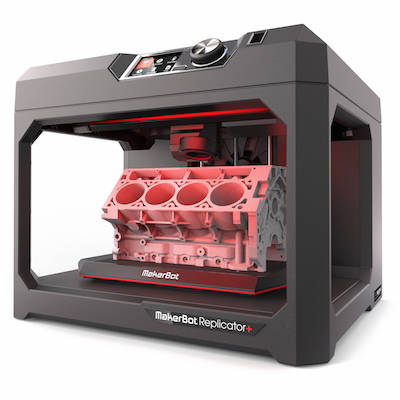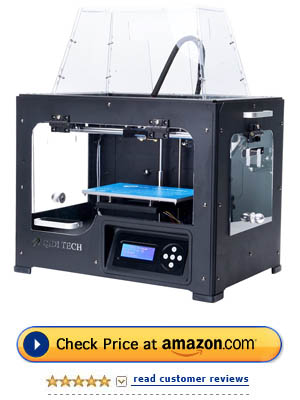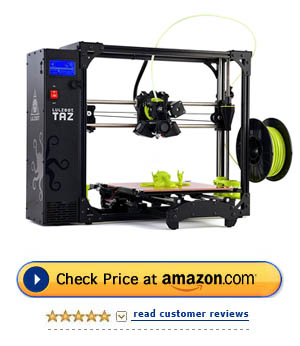How Much Does a 3D Printer Cost?
The average consumer 3D printer costs around $700. The cheapest 3D printers start at around $200. High end consumer 3D printers can cost several thousand dollars.

The cost of 3D printers has dropped considerably over the past three years. As late as 2014, it was hard to find quality 3D printers for under $2000. Today, numerous high-quality options exist for under $1000.
The price of 3D printers for professionals is a lot more than for hobbyists. This is because professionals tend to invest in higher-quality equipment. According to Sculpteo, the average professional had a budget of $9504 for 3D printing in 2017. This is up 55% compared to 2016, which indicates that companies are finding more value in 3D printers.
If you want to know how much a 3D printer will cost there are questions you need to ask yourself first. As with all electronic devices there are different makes and models to suit different needs. 3D printers are no exception.
Whether you’re buying a 3D printer for home or office, begin by asking these two questions:
- What do you want a 3D printer for (be specific)?
- What is your budget?
It’s a simple start, but it’ll give you a great foundation when it comes to narrowing down your choices. By answering these two questions you’ll be able to make a much better informed decision.
The Different Types of 3D Printer
The 3D printer you want may not be the one you get. This could because it’s not available or it’s out of your budget. To make your choices simpler you need to search the category that’s right for you.
The five 3D printer categories include:
- Entry level 3D Printers
- Hobbyist 3D Printers
- Enthusiast 3D Printers
- Professional 3D Printers
- Industrial 3D Printers
The size, capability, features, and the price of a machine change for each category. An entry level 3D printer can start as low as $200, whereas a top end industrial machine can go for well over $100,000.
3D printers are always changing. That’s great news for consumers. It means we get better machines for less money.
OK, let’s take a look at what you can expect from each of these categories:
See Our Top Picks for 3D Printers in 2018
We have spent hundreds of hours to find the best 3D printers on the market. We looked at various factors including price, reviews, and hands-on testing to pick our winners. We have pros and cons for each printer as well as technical specifications. Take a look at our detailed guide to help you make a decision.
Entry Level Category 3D Printers
 Entry level 3D printers are for novices. They are a great way to learn about the technology before upgrading to a more expensive model. They generally have a gentle learning curve. Your experiments will have limitations though.
Entry level 3D printers are for novices. They are a great way to learn about the technology before upgrading to a more expensive model. They generally have a gentle learning curve. Your experiments will have limitations though.
Most entry-level machines won’t let you print much over 3-4″ in any dimension (height, length, and width). Another restriction is with material choice. Most printers will only allow you to use one filament.
An entry-level 3D printer can be noisy and slow compared to more expensive models. The print quality isn’t all that impressive either. They are also not very durable. Despite this, they’re wonderful learning tools and act as a great stepping stone for anyone who wants to progress to better things later on.
| Entry level 3D printer price range: | $200 – $400 | |
| Limitations: | Build volume is a major constraint. You can typically print only smaller items. Entry level printers are often much slower and less precise than higher end machine. You can expect 100 micron resolution and you are often limited in which materials you can use. Finally, you might have to assemble the machine yourself which can be hard depending on the model. | |
| Best 3D Printer: | FlashForge Finder | |
Hobbyist Category 3D Printers
Hobbyists are people who have some experience with 3D printing and have developed the bug. They now have a real passion for it and want to get more creative with their 3D models. Hobbyist 3D printers are very capable machines, especially at the higher end of this category.

Hobbyist 3D printers let you print bigger 3D parts than entry level machines. You still won’t be able to make anything much over 5-6″ in either dimension with most models.
Most hobbyist 3D machines are faster than entry-level options. They offer more flexibility with material choices too, which means you can get extra creative with your 3D parts.
The 3D printers for hobbyists are a good step up from the more basic models. Even so, they’re still not capable of much more than printing for pleasure. They’re not as robust or as reliable as the following categories either, so you won’t want to leave them running for too long or use them too often.
| Hobbyist 3D printer price range: | $300 – $1,500 | |
| Limitations: | You get a slightly larger build volume with this price range. You will be able to print with more materials in this price range. You will also have smoother prints. Make no mistake though, these printers are still for hobbyists. 3D printers at this cost also have much better software that is capable of auto-leveling and cleaning. | |
| Best 3D Printer: | QIDI Tech I | |
Enthusiast Category 3D Printers
You’re now a 3D printing enthusiast if you are ready to take your hobby to a more serious level. That means you’ll want to find an enthusiast category 3D printer to meet to your needs.
Here’s a quick breakdown on what you can expect from a 3D printer in this class:
- A solid, robust printer with lots of user-friendly features
- Prints up to 8-12″ in either dimension
- Quite a bit *faster and quieter than entry and hobbyist level 3D printers
- Wider choice of materials, though some will use brand-only filaments

It’s important to note that even at this level you won’t want to go into production. There’s a reason why they’re in the enthusiast’s 3D printers category and not the professional.
You could find yourself performing frequent repairs and maintenance if you run them for too long and often. Many of these machines are perfect for regular use, but not continuous use.
* Faster printing might sound great, but always choose slower print speeds if you want to produce 3D parts with the best quality.
| Enthusiast 3D printer price range: | $1,500 — $3,500 | |
| Limitations: | The quality of prints really starts to increase in this price range. In fact, you will usually get twice as good resolution (50 vs. 100 microns). Printers at this cost are well-built and can take some abuse. The build volume is much larger and you will be able to print faster. | |
| Best 3D Printer: | LulzBot TAZ 6 | |
Professional Category 3D Printers
To buy a 3D printer from the professional category means your machine “works” for you. Either that or you’ve got plenty of spare cash to splash out on a serious hobby.
These machines print high-quality 3D parts, and some boast a build area of around 12″ (all dimensions). The range of 3D print materials, including different textures and multiple colors, is now greatly expanded. The best machines in this category can also print fast while maintaining quality.
Find out a printer’s durability by reading real user reviews. For example, does it need regular maintenance? If yes, how easy is it to keep up? What are its pros and cons, and do any of those cons apply to you and your setup? You get the idea.
These printers are not cheap. To make the best decision, make sure any models you shortlist check all the right boxes.
People who invest in a professional 3D printer typically include:
- Schools and universities
- Robotics clubs
- Businesses – large and small enterprises
| Professional 3D printer price range: | $3,500 – $6,000 | |
| Limitations: | You can run printers in this class continuously without a problem. You might also see increased resolution and enclosures to keep the printing temperature constant. | |
| Best 3D Printer: | Fusion3 F400-S | |
Industrial Category 3D Printers
No one goes in blind when choosing a 3D printer from the industrial category. These are serious machines for serious business. They can print high-quality parts faster than any other category.

These machines are highly durable, built with plenty of metal in their construction. They also include efficient user-friendly interfaces for custom printing modes. They are not DIY 3D printers. That means there’s usually an extra maintenance fee with most models.
There may also be restrictions with materials and material availability. Filament can cost more compared to printers in the enthusiast and professional categories too. Still, anyone who buys one of these beasts should know all their options beforehand.
Although there’s a definite niche for industrial 3D printers, they’re on the decline. Many of the cheaper, professional machines are starting to compete with these mega-priced printers.
Today, big businesses have more to choose from. It now makes sense to include a few high-end professional 3D printers in with their shortlist of options. The price range below tells us why!
| Industrial 3D printer price range: | $20,000 – $100,000 | |
| Limitations: | Price and size. | |
Closing Thoughts
It’s important to remember that the cost of the 3D printer is but one part of the overall cost to 3D print. You will also need to pay for electricity, maintenance, software (in some cases), and filaments. You can expect to pay around $20 per kg of filament.
3D printers are becoming more powerful everyday. There’s a lot you can do with these powerhouses that makes it worth the price tag.


